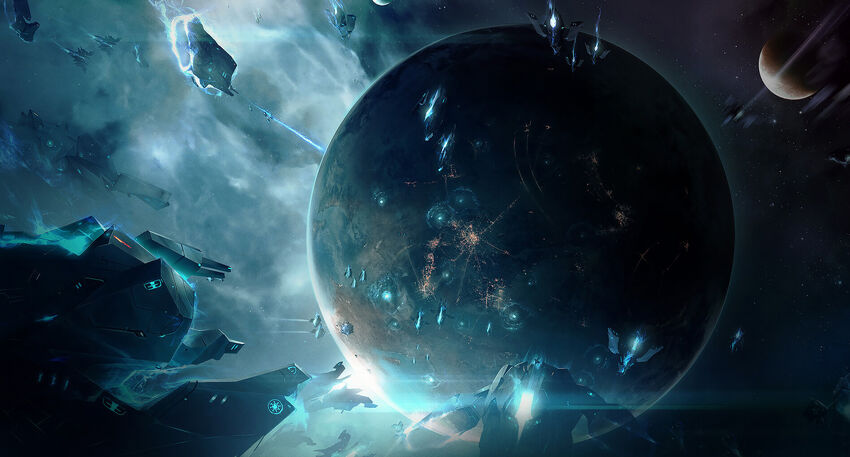The galaxy is the stage for games of Endless Space 2, and the majority of play takes place in the galaxy view. Galaxy type can be selected during the game setup phase, but each contains a large number of Star Systems connected by Star-lanes. Fleets can only move to a System that has already been discovered, and follows star-lanes until warp technology is discovered.
Galaxy Shape[]
Different types of galaxies can be selected during game setup, and offer a variety of patterns for the placement of Systems.
- Ovoid - An old galaxy whose arms have disappeared, forming a stretched elliptical galaxy. This is like a flattened disc galaxy.
- Ring - A galaxy shaped like a ring
- Disc - 4 - An elliptical galaxy with four sectors
- Spiral - 2 - A spiral galaxy with two arms
- Spiral - 4 - A spiral galaxy with four arms
- Spiral - 6 - A spiral galaxy with six arms (Community Challenge Pack)
- Spiral - 8 - A spiral galaxy with eight arms
- Twin Elliptical - Two disc galaxies colliding and merging. The center contains many stars.
- Random - The shape of the galaxy will be chosen randomly
See also the shape settings information for the earlier 2012 Endless Space game, but note that some info on that page does not apply to the current Endless Space 2 game.
Galaxy Size[]
This determines the number of stars in the galaxy (this is further affected by System Density).
| Size | Suggested
Players |
Systems | Unique Planets | Isolated Nodes | Conquest Victory |
|---|---|---|---|---|---|
| Tiny | 2 | 30 | 1 | 6 | 16 (51%) |
| Small | 4 | 40 | 2 | 8 | 19 (45%) |
| Medium | 6 | 60 | 3 | 12 | 22(37%) |
| Large | 8 | 80 | 4 | 16 | 28 (35%) |
| Huge | 10 | 100 | 5 | 20 | 32 (32%) |
| Collossal | 12 | 120 | 6 | 24 | 36 (30%) |
| Exceptional | 140 | 7 | 28 | 40 (29%) |
Density[]
The average number of stars per galaxy size.
| Density | Low | Normal | High | Random |
|---|---|---|---|---|
| Number of Systems | 75% | 100% | 150% | 75%-150% |
Constellations[]
Each galaxy is composed of multiple constellations, which are clusters of Systems connected by star-lanes. When the galaxy view is zoomed out, the name of each constellation can be seen. In most games, 1-2 players will start out in the same constellation somewhere near the fringes of the galaxy. The shape of constellations is usually determined by the galaxy type, and the number of constellations can be changed in advanced game setup.
- Unique - The galaxy consists of a single large constellation.
- Few - The galaxy will consist of a lesser number of constellations, depending on the minimum value set by its shape.
- Many - The galaxy will consist of a larger number of constellations, depending on the maximum value set by its shape.
Age[]
The age of the galaxy determines the probability of each Star Type. A younger galaxy will provide habitable planets less often than an old one.
- Young - The galaxy will have more younger, hotter stars.
- Normal - The galaxy will be a mix of hotter and cooler stars.
- Old - The galaxy will have more older, cooler stars.
- Random - The age of the galaxy will be chosen randomly
Node Connectivity[]
The number of connections that each node (generally a System) has.
- Low - Few connections
- Medium - Average number of connections
- High - Many connections
Wormholes[]
Constellations never connect with one another through star-lanes, but can be reached through warp-drive technology or the discovery of wormholes. Wormholes advanced star-lanes that are only visible once unlocked in Stage 4 of Science and Exploration. When a fleet uses a wormhole, they are instantly transported to a System on the other end, but expend all movement points for the current turn. Travelling through wormhole require any amount of movement points. If you have fleet with 1/9 movement points left you will still be able to travel through wormhole instantaneously so it can be useful to travel through them at the end of your movement. However, it's quite unlikely to have control over it because of linear and predestined type of movement in game. Wormholes are very useful for quickly traversing the galaxy or bypassing the choke points in star-lanes. There are typically around 3 wormholes that can be discovered in each constellation, each connecting to another nearby constellation, but many more can be found surrounding the galactic core.
The Galactic Core[]
An extra constellation is usually found around the galactic core. It often contains large Systems, and almost always includes The Academy. Colonized Systems in the galactic core are more vulnerable to attack by opponents, but offer enticing rewards for trade and considerable control of the galaxy. It is advisable to send Probes towards the galactic core to warp to those systems, meet other civilizations quickly, and find the academy.
Miasma[]
At the start of the game, only star-lanes and Systems close to the player can be seen. The rest is hidden by the miasma, the terra incognita of Endless Space 2. Systems, Ships, and Probes have a vision-range that permanently reveals Systems and Galactic Objects. Sometimes, rogue systems and galactic objects can be found floating around in the miasma, within or outside of constellations.

